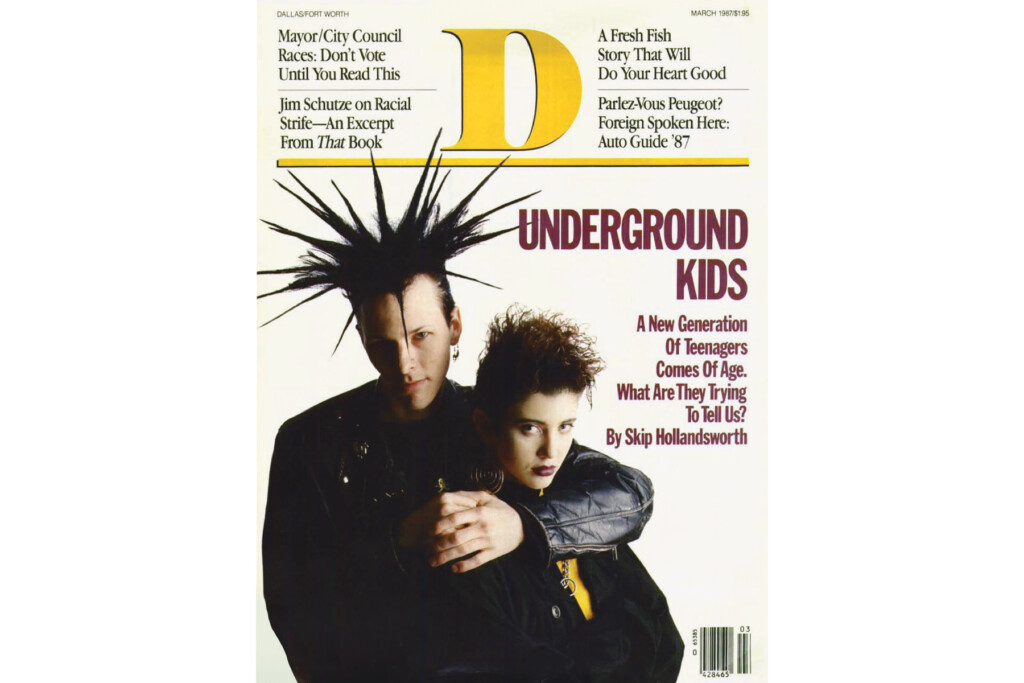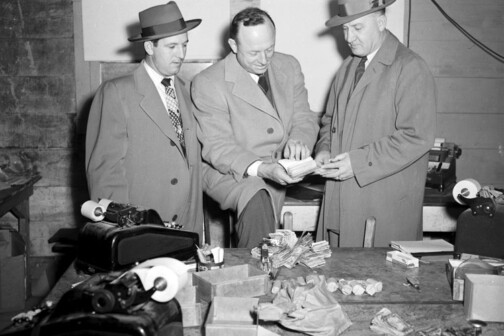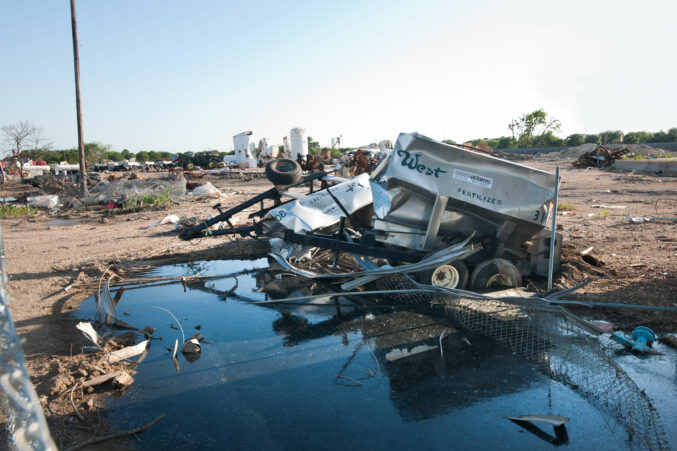By the generations still alive to argue the case, the years 1984 to 1988 are most often cited as Deep Ellum’s heyday, a time and a place where you might find a suburban 16-year-old checking IDs at the club door and ecstasy on every corner. It was a scene captured by a young Skip Hollandsworth for this magazine’s March 1987 cover story, whose subtitle read: “Underground in Deep Ellum: a generation of kids searches for identity. Are they part of a new counterculture? Or are they rebels without a cause?”
That outside-looking-in take was, at the time, a sore point for some on the inside. “With all the creative types in the scene—writers, poets, and songwriters—it seemed like D Magazine could have gotten somebody that was more in touch,“ says David Adriance 36 years later. He appeared in the story as a skateboard punk known on the streets as David Dude. “All these kids, even the wealthy ones, were considered black sheep and kind of lost themselves, and we all found unity with creativity.”
Those creative connections would serve as David Dude’s ramp into many adventures. He rubbed elbows with rock stars around the world while working as the merch manager for Dallas’ Reverend Horton Heat. Once, while visiting his Starck Club-investor girlfriend in Paris, he met a pair of French artists who negotiated the sale of his orthopedic cast—which had been drawn on by graffiti-art legend Keith Haring. The proceeds funded a summer of European surfing.
At the time of the article, though, David Dude was living at the Theatre Gallery, a warehouse-turned-illegal event space that many young bohemians called home over the years. The Theatre Gallery’s founder, Russell David Hobbs, was more or less Deep Ellum’s master of ceremonies, presiding over a three-ring circus of visual, theatrical, and musical artists who were given free rein inside the space. “At that moment, it was really about real, convicted artists, painting and spilling their guts out onstage through theater and live music,” Hobbs says, “and the street scene was an exploration into art and reality and social experience. We were all trying to break on through to the other side.”
Bailey says he still owes an apology to the young woman posing on the cover with him, Suzanne Boisvert, for the day he met her famous new beau, Martin Gore of Depeche Mode.
Many from the scene remember the spiky-haired young man on the cover, Matthew Bailey, who was sleeping in his sedan when Hollandsworth knocked on the window to pass along the address for the photo shoot. Bailey says he still owes an apology to the young woman posing on the cover with him, Suzanne Boisvert, for the day he met her famous new beau, Martin Gore of Depeche Mode.
“I was a little out of it on a few chemicals popular in those days,” Bailey says. “And when I saw him, I kept seeing the baby owl from the prewar Looney Tunes cartoon ‘The Egg Collector.’ ” Bailey answered our questions in rapid, thousand-word messages on his iPad while recovering from throat surgery. Given his difficulties communicating these days, Bailey asked D Magazine to pass along a message to “a girl whom I should have worked harder to stay with.” The message, which may or may not be related to the Depeche-owl anecdote: “Kaati, Matthew says ‘HOOOOT!’ ”
As for how Boisvert ended up on the cover, the story is more straightforward. Her Page Parkes modeling agent sent her to the casting call since the Berkner High School senior was known to frequent the scene. Not that her parents had any idea she was club hopping with friends every weekend. “We would literally sneak out,” Boisvert says. “I had my friend’s sister’s ID, like the paper one you get before your real one.”
A couple months after becoming a D cover girl, Boisvert graduated and had two choices: either go to the University of North Texas or work for a modeling agency in Paris. Just a week into her French adventure, Boisvert’s new roommate took her to a new wave club. “This guy is talking to me, and suddenly she pulls me away like, ‘Oh my God, do you know who you’re talking to?’ I was like, ‘No.’” Martin Gore and Boisvert had three children together and then split in 2004.
Over the years, she has produced her own lingerie line, opened a spa in Santa Barbara, worked as a DJ, and recently self-published two sci-fi novels based on a story that’s been brewing in her mind since those wild high school days, a season she looks back on fondly. “It was a really cool time in Dallas, like it was just freedom.” Boisvert says. “I grew up in a family that was very religious, and it was just a way to be free and express yourself through your own creativity. A lot of us had to be secret about the kind of music we liked, because it was Sex Pistols and stuff like that.”
So how does a heyday end? Certainly its end is inevitable, especially when said heyday involves sex, drugs, and rock and roll. Bailey says he still suffers from survivor’s guilt thinking about the many who were felled by overdoses, AIDS, suicide, and acts of violence. But the scene’s unraveling might also involve the Theatre Gallery’s janitor. It was he who drove Hobbs to a church service inside a South Oak Cliff apartment and proceeded to speak the gospel to the long-haired club owner.
“They broke all those evangelistic rules, like, don’t tell people they’re going to hell,” Hobbs says. No matter, Hobbs walked out of that apartment feeling “like a newborn little baby.” He returned to his bar and ordered all alcohol to be poured down the drain. The next day, he canceled on 50 bands.
“I was the one that built the scene and crazy enough to do everything that wasn’t for money,” Hobbs says. “So, yeah, when I turned my life to God, the whole scene shifted, and all that was left was people trying to make money off artists. It became commercial.”
Matt Goodman’s report on the Deep Ellum of today can be found here. Hobbs, for his part, is currently in postproduction on a documentary about the district’s underground days. The working title: Round Pegs, Square Holes: The History of Deep Ellum.
This story originally appeared in the January issue of D Magazine with the headline “Wild Things.” Write to [email protected].
Author








